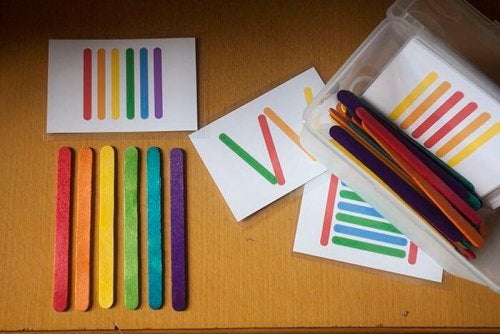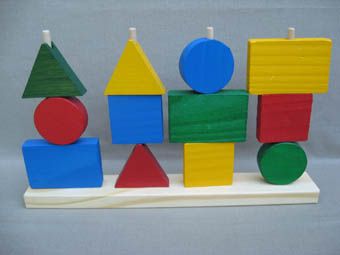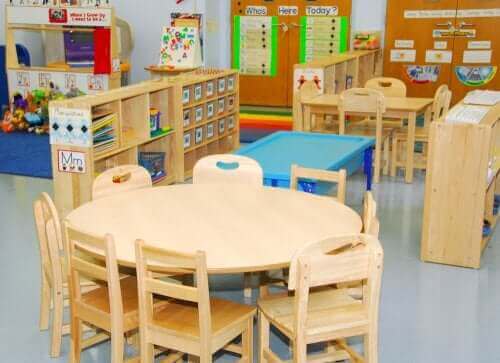5 Didactic Preschool Resources to Use at Home

Education in small children is very important because, at this stage, they’re ready to absorb almost any knowledge. However, to plan educational activities using didactic preschool resources, you need to keep in mind that little ones need the motivation to be active in these tasks, meaning they must be designed according to their age and be very attractive.
Of course, we know that teachers have the necessary training to know how to work with children, but when kids begin school, they should already have received some education at home. So, this period serves to prepare them for their future entry to school, which is why knowledge of some tools can be very useful.
5 didactic preschool resources you can use at home
We can help our children a great deal if we implement some of the tools that are used in school, as doing so will give them a certain advantage when they’re with their teachers. From home, we can help them to identify colors and shapes, and also to develop their motor skills and relate to the concepts of the preschool stage.
To contribute to their educational development, we recommend taking home at least the following five didactic resources that we’ll offer you below. Remember that they’re simple activities and what matters is that you’re children are motivated to that they enjoy while they learn.
1. Puzzles
This resource is basic and easy to carry out at home. Also, puzzles are simple to use and easy to explain to children. According to the child’s stage of development, this instrument can be made from any image, but it must be small, and its pieces should be large and few. Three to six pieces is fine.
To apply this resource, you can encourage the child to form an image from the fragments, inviting them to imagine something; but you can also invite them to form the figure they see for reference. It’s best to use simple images that are easy for the child to recognize and that have bright colors and well-defined edges.
2. Classification of colors and shapes

To classify figures according to shape or color, one must have basic knowledge; It seems simple to adults, but for a child, it can be a challenge. So, if we teach them this at home, they’ll have gained a very useful skill for their school years. You can go about it in different ways, but colored geometric figures are advisable.
You can buy ready-made games, but if you make them at home with your little ones, you also gain education time with your child. Make five to ten geometric shapes, each a different color. They can be large pieces of cardboard. For example, two circles, one blue and one red; the repeated figures must have a different color.
To apply this resource, the child is asked to classify the figures. This can be by their shape, by their color, or by the quantity of each one. You can also ask them to order them in sequence, which is helpful for developing language and mathematical ideas.
3. Dice
Dice are a multifaceted resource and are easy to use and are entertaining for children. They can be bought or made, and depending on their characteristics, they can be used to teach language, the association of colors and numbers, etc. They also contribute to the child’s motor development.
These should be cubes of a size proportional to the child’s hand, but easy to see. There are all different types of dice: They can have dots, shapes, textures, colors, and vowels; which vary on each side of the same die.
The purpose of this resource is for children to learn to associate language with the elements they perceive. As they develop their motor skills when rolling the die, they recognize when it lands on a red, or six, or a certain letter or shape, etc.
4. Dominoes
This teaching material is very versatile, and like dice, it provides opportunities for the child to begin to associate many elements of language, their environment, and mathematical ideas. The activity consists of matching images that are the same, whether in texture, shape, color, or number.
There are dominoes with images of fruits, geometric figures, funny characters, or just colors. The application of this material focuses on the recognition of the pieces, and their size must be in accordance with the child’s motor development.

5. Montessori cubes
The Montessori method is an educational element designed to favor the development of children in different stages. Specialists base the application of this system on the fact that learning comes from observation, experimentation, and adaptation of the daily context.
The Montessori cubes, based on this philosophy, are also didactic preschool resources and vary according to the child’s development stage. In this case, it’s a dice where each side presents a different activity to promote fine motors skills: Tying, closing, buttoning, uncovering, zipping, etc. They also provide skills so that the child can function better in everyday life.
All cited sources were thoroughly reviewed by our team to ensure their quality, reliability, currency, and validity. The bibliography of this article was considered reliable and of academic or scientific accuracy.
- Albarracín, A., & Peña, V. A. (2019). El Dominó como Estrategia de Aprendizaje para el desarrollo del Pensamiento Lógico Matemático en el Nivel de Preescolar de una Institución Pública de Bucaramanga [Tesis de maestría, Universidad Autónoma de Bucaramanga]. Archivo digital. Disponible en: https://repository.unab.edu.co/handle/20.500.12749/6958
- Bello, E. Y. (2021). Aprendo en casa: creamos y elaboramos objetos con material reciclado a través del juego. [Tesis de grado, Universidad Nacional de Trujillo]. Archivo digital. Disponible en: https://dspace.unitru.edu.pe/handle/UNITRU/17181
- Casadiego, A., Avendaño, K., Chávarro, G., et al. (2020). Criterios de clasificación en niños de preescolar utilizando bloques lógicos. Revista latinoamericana de investigación en matemática educativa, 23(3), 311-330. https://dialnet.unirioja.es/servlet/articulo?codigo=7676663
- Gasteiger, H., & Moeller, K. (2021). Fostering early numerical competencies by playing conventional board games. Journal of Experimental Child Psychology, 204, 1-15. Disponible en: https://www.sciencedirect.com/science/article/pii/S0022096520305142?via%3Dihub
- Levine, S. C., Ratliff, K. R., Huttenlocher, J. & Cannon, J. (2012). Early puzzle play: a predictor of preschoolers’ spatial transformation skill. Developmental psychology, 48(2), 530-542. Disponible en: https://www.ncbi.nlm.nih.gov/pmc/articles/PMC3289766/
- Martín, D. (2022). La metodología de María Montessori [Tesis de grado, Universidad de Valladolid]. Archivo digital. Disponible en: https://uvadoc.uva.es/handle/10324/57869
- Peñaflor, G. (2020). El juego como coadyuvante para la mejorar en el desempeño de las actividades de la vida diaria en el alumno con debilidad visual y discapacidad asociada de un multigrado II [Trabajo de grado, Benemérita y Centenaria Escuela Normal del Estado de San Luis Potosí]. Archivo digital. Disponible en: https://repositorio.beceneslp.edu.mx/jspui/handle/20.500.12584/605
- Zamora, G. C. (2020). Uso del rompecabezas en el aprendizaje de los niños de nivel inicial [Trabajo de grado, Universidad Nacional de Tumbes]. Archivo digital. Disponible en: https://repositorio.untumbes.edu.pe/handle/20.500.12874/2109